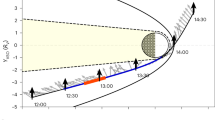Abstract
EUROPA, one of the satellites of Jupiter, has long been thought to be a dormant icy body1, unlike its volcanically active neighbour, lo. Europa lies deep within Jupiter's magnetosphere, however, and is continuously bombarded by energetic ions, which modify the surface ices2 and are probably responsible for creating Europa's tightly bound oxygen atmosphere3,4. Here we report the discovery of an atmosphere of atomic sodium that extends to at least 25 times Europa's radius. We suggest that this sodium is originally released by lo's volcanoes, after which it is ionized in the magnetosphere and implanted into Europa's surface ice; subsequent sputtering of the ice by magnetospheric ions releases the sodium to form the extended atmosphere. Although sodium is a minor constituent of Europa's atmosphere, it traces the distribution of the major atmospheric components which are not themselves directly observable. The sodium and oxygen could represent the extremes of the distribution of the atmospheric components, with only the heaviest molecules (such as the oxygen) being tightly bound; alternatively the sodium might be in the form of an extended corona, analogous to lo's atmosphere.
Similar content being viewed by others
References
Clark, R. N., Fanale, F. P. & Gaffey, M. J. in Satellites (eds Burns, J. A. & Matthews, M. S.) 437–491 (Univ. Arizona Press, Tucson, 1986).
Johnson, R. E., Nelson, M. L., McCord, T. B. & Gradie, J. C. Icarus 75, 423–436 (1988).
Hall, D. T., Strobel, D. F., Feldman, P. D., McGrath, M. A. & Weaver, H. A. Nature 373, 677–679 (1995).
Johnson, R. E. Energetic Charged-Particle Interactions with Atmospheres and Surfaces (Springer, Berlin, 1990).
Hunten, D. M., Wells, W. K., Brown, R. A., Schneider, N. M. & Hilliard, R. L. Publs astr. Soc. Pacif. 103, 1187–1192 (1991).
Brown, R. A. & Yung, Y. L. in Jupiter (ed. Gehrels, T.) 1102–1145 (Univ. Arizona Press, Tucson, 1976).
Schneider, N. M., Hunten, D. M., Wells, W. K., Schultz, A. B. & Fink, U. Astrophys. J. 368, 298–314 (1991).
Bagenal, F. J. geophys. Res. 99, 11043–11062 (1994).
McNutt, R. L., Belcher, J. W., Sullivan, J. D., Bagenal, F. & Bridge, H. S. Nature 280, 803–804 (1979).
Smyth, W. H. & Combi, M. Astrophys. J. 328, 888–918 (1988).
Allen, C. W. Astrophysical Quantities (Athlone, London, 1973).
Author information
Authors and Affiliations
Rights and permissions
About this article
Cite this article
Brown, M., Hill, R. Discovery of an extended sodium atmosphere around Europa. Nature 380, 229–231 (1996). https://doi.org/10.1038/380229a0
Received:
Accepted:
Issue Date:
DOI: https://doi.org/10.1038/380229a0
- Springer Nature Limited
This article is cited by
-
Moons and Jupiter Imaging Spectrometer (MAJIS) on Jupiter Icy Moons Explorer (JUICE)
Space Science Reviews (2024)
-
Sulfur Ice Astrochemistry: A Review of Laboratory Studies
Space Science Reviews (2021)
-
The Origin and Fate of O 2 $\mbox{O}_{2}$ in Europa’s Ice: An Atmospheric Perspective
Space Science Reviews (2019)
-
Towards a Global Unified Model of Europa’s Tenuous Atmosphere
Space Science Reviews (2018)
-
An Impacting Descent Probe for Europa and the Other Galilean Moons of Jupiter
Earth, Moon, and Planets (2017)





